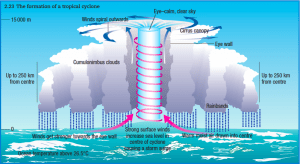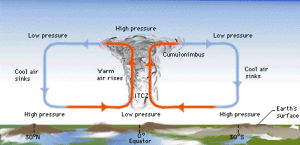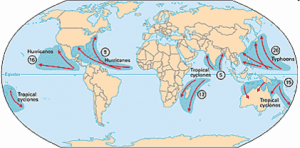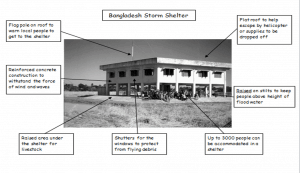Tropical storms can be called hurricanes, typhoons or cyclones.
Hurricanes hit North America and the Caribbean. They occur in the Atlantic Ocean or the eastern Pacific. They affect countries such as the USA, Mexico, Cuba and Jamaica.
Typhoons hit Asia. They occur in the north west Pacific Ocean. They affect countries such as Japan, Philippines and China.
Cyclones hit Asia, Africa or Oceania. they occur in the Indian Ocean or south west Pacific Ocean. They affect countries such as Australia, India and Mozambique.
 Tropical storms have characteristic features. They can be 500 km across and 15km high. In the centre is the eye, where the winds are calm and the skies are clear. Around the eye is the eye wall, where the wind speads are strongest. Air is rising in the eye and this create low pressure at the surface. The spiral rain bands mark where rising air cools and forms clouds and rain.
Tropical storms have characteristic features. They can be 500 km across and 15km high. In the centre is the eye, where the winds are calm and the skies are clear. Around the eye is the eye wall, where the wind speads are strongest. Air is rising in the eye and this create low pressure at the surface. The spiral rain bands mark where rising air cools and forms clouds and rain.
 Tropical storms are caused by the sun heating the Earth’s surface at the equator. The heat evaporates water and the hot air, which is less dense, rises. This hot air carries water vapour into the atmosphere. As it rises the air cools and water vapour condenses. This release more energy fuelling the storm.
Tropical storms are caused by the sun heating the Earth’s surface at the equator. The heat evaporates water and the hot air, which is less dense, rises. This hot air carries water vapour into the atmosphere. As it rises the air cools and water vapour condenses. This release more energy fuelling the storm.
The low air pressure created in the eye as air rises sucks in air at the surface. These winds blow towards the centre of the storm. The spin of the Earth means these winds blow in a spiral. In the northern hemisphere winds blow anti-clockwise and in the southern hemisphere, clockwise. This is called the coriolis effect.
Tropical storms only form over oceans warmer than 26 degrees C and when there are light winds in the atmosphere. Tropical storms decay when the cross over land, cooler water or meet strong winds in the upper atmosphere.
CASE STUDY
 Typhoon Haiyan occured in 2013. The typhoon began in the north west Pacific Ocean. It increased in intensity until it became a category 5 storm with eye wall speeds of 195mph. It his the Philippines, in Asia, on 8th November 2013.
Typhoon Haiyan occured in 2013. The typhoon began in the north west Pacific Ocean. It increased in intensity until it became a category 5 storm with eye wall speeds of 195mph. It his the Philippines, in Asia, on 8th November 2013.
Typhoon Haiyan caused much damage in the Philippines. The country was not prepared for the storm surge which accompanied the typhoon. This caused sea levels to rise and flood the land. Primary effects were those caused the storm itself. Secondary effects were caused indirectly. Immediate responses were needed straight away and long term responses only months later.
|
Typhoon Haiyan, Philippines, Asia |
|
|
7th November 2013 In the Pacific Ocean Wind speeds 195mph |
|
| Effects | Responses |
| · 6300 people killed.
· 1.9 million people homeless. · 6 million evacuated. · Damage $2.8 billion. · Many injuries from flying debris. · 6m storm surge flooded sea water up to 1km inland. · 1 month with no electricity in many places. · Many cases of diarrhoea because of the lack of clean water. · No power or radio meant that aid flights were delayed. · Heavy rain caused landslides, which blocked roads and prevented food being distributed · Lack of food and supplies lead to looting from shops by survivors |
· Several countries, such as USA, sent hospital ships to help people injured in the typhoon.
· 3 million people given food aid, supplied by countries around the world. · Farmers supplied with new seeds and tools to replace what was washed away. · New typhoon warning systems introduced. · Clean water and sanitation restored in Tacloban city · Government sent in army to restore order following looting. · New evacuation plans prepared for coastal communities. · Tarpaulins distributed to fix broken roofs. · People relocated to higher ground when homes are rebuilt. |
Tropical storm warnings
In HICs, such as the USA, you can warn people about an approaching hurricane with satelite tracking, text message alerts, emergency TV broadcasts.
In LICs, such as Bangladesh, you can warn people with flood warning officals who use a megaphone and a system of 3 flags to issue alerts.
Tropical storm planning
In HICs, such as the USA, homes can have a survival kit for the aftermath, evacuation routes can be prepared to safely move people away from the coast.
In LICs, such as Bangladesh, charities can train people to repsond after a storm and save lives.
Designing buildings for tropical storm safety
In HICs such as the USA
In LICs such as Bangladesh
Global warming and tropical storms
Global warming is increasing temperatures around the world. Warmer ocean waters may trigger changes in the intensity, frequency or distribution of tropical storms.
Intensity – There used to be 5 category five typhoons per year in the Pacific Ocean. Today there are 8 category five typhoons per year. Typoons seem to be getting stronger.
Frequency – There used to be 10 hurricanes per year in the Atlantic Ocean in 1970. Today there are 15 hurricanes per year on average. Hurricanes seem to be getting more frequent.
Distribution – The Indian Ocean and the Pacific Ocean are predicted to get warmer. This may mean cyclones occur further north or south as water temperatures rise over a larger area.


